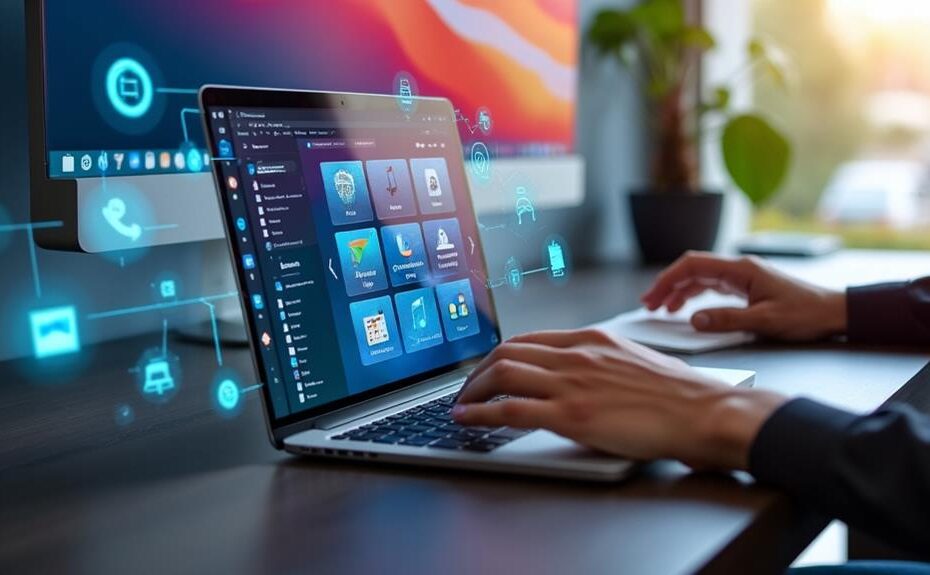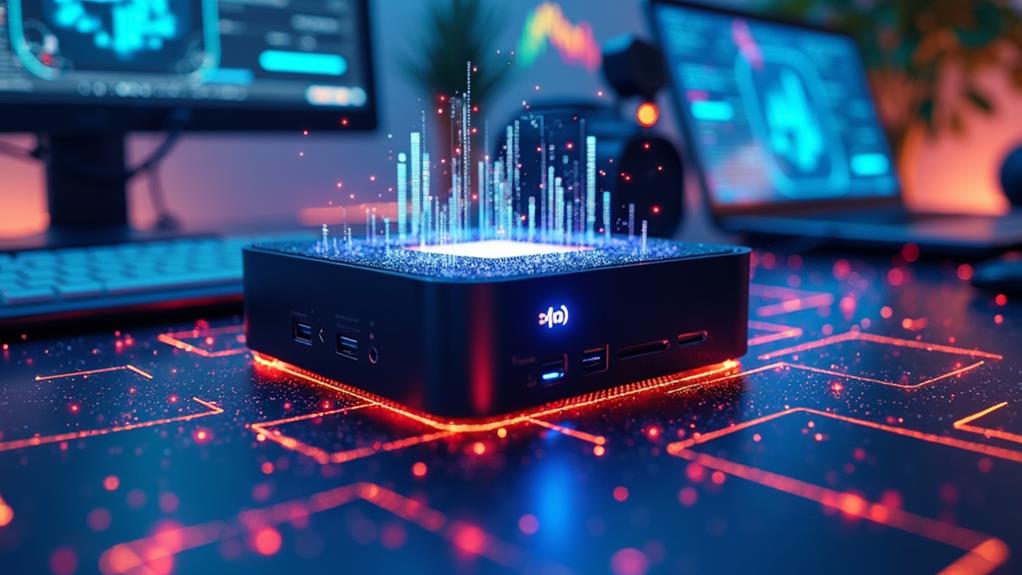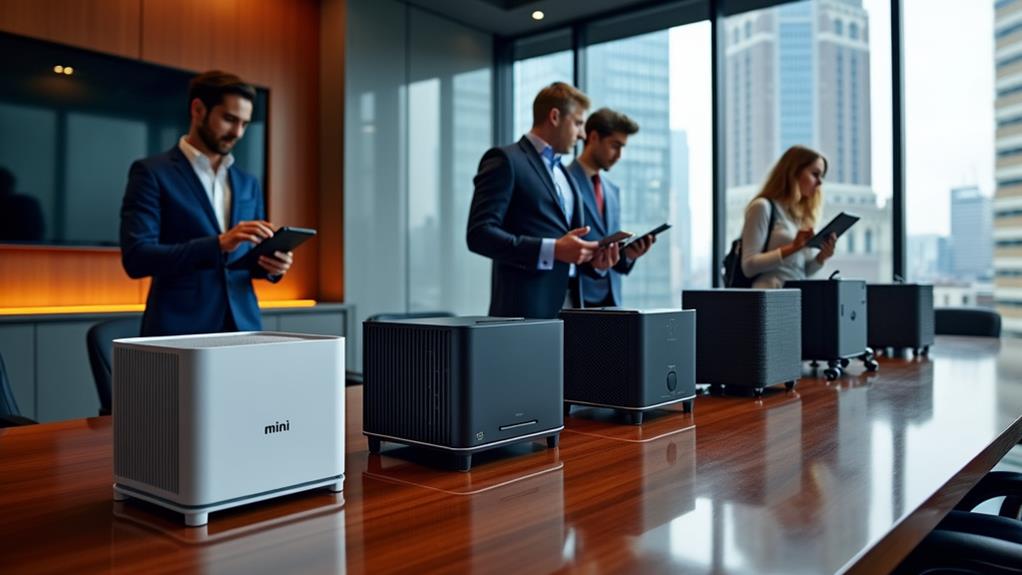



Mini PCs handle modern web browsing tasks efficiently due to their compact design and energy-efficient processors. With RAM options ranging from 4GB to 16GB, you can manage multiple browser tabs seamlessly, enhancing your multitasking experience. Their use of solid-state drives guarantees faster loading times, making your online navigation smooth. Connectivity features like USB ports and Wi-Fi support facilitate easy connections to peripherals and external displays. While they're perfect for everyday computing, they may not match the performance of high-end desktops. If you're curious about their specific advantages and limitations, you'll find more insights ahead.
Key Takeaways
- Mini PCs utilize energy-efficient processors, enabling smooth multitasking and efficient management of multiple web browser tabs for modern browsing tasks.
- With RAM configurations of 8GB to 16GB, mini PCs support seamless multitasking, ensuring a fluid user experience during web browsing.
- Solid-state drives (SSDs) in mini PCs provide faster boot and loading times, enhancing access to frequently visited websites for improved browsing efficiency.
- Their compact design allows for easy connectivity to external displays and peripherals, enriching the overall web browsing experience.
- While ideal for everyday computing, mini PCs may struggle with high-performance gaming or intensive applications, focusing primarily on web browsing and basic tasks.
Understanding Mini PCs
Understanding mini PCs starts with recognizing their design and functionality. These compact devices are engineered for energy efficiency, making them ideal for modern web browsing tasks. With processors like Intel Celeron or AMD Ryzen, you can smoothly handle multiple tabs without experiencing significant lag. This performance is essential, especially when you're working on tasks like email, document editing, or streaming. Moreover, their key advantages in industrial applications highlight how they can support varied operational needs with their robust features.
The typical RAM in mini PCs ranges from 4GB to 16GB, providing ample capacity for basic productivity applications and web browsing. Their compact size allows you to place them virtually anywhere, fitting snugly into smaller workspaces, which is a game-changer if you're short on desk space.
Connectivity options are another strong point; most mini PCs come equipped with multiple USB and HDMI ports, making it easy to connect to monitors and external drives. This versatility enhances your web browsing experience by allowing you to expand your setup effortlessly. Additionally, with various storage options, including SSDs and HDDs, you'll enjoy quick access to your frequently used files and applications, boosting your overall efficiency during those internet browsing sessions.
Key Hardware Specifications
When selecting a mini PC for web browsing tasks, the hardware specifications play a significant role in guaranteeing ideal performance. You'll want to start with energy-efficient processors, like Intel Celeron or AMD Ryzen, but for those seeking more power, the Intel i5-1135G7 processor offers impressive capabilities for multitasking and demanding applications. These processors deliver the necessary power for smooth web interactions without consuming excessive energy.
Next, consider the RAM capacities. Most mini PCs support configurations ranging from 4GB to 16GB, which is essential for multitasking, especially when juggling multiple Chrome tabs. More RAM means smoother changes and less lag when switching between tasks.
Storage options are equally important. Opt for mini PCs with SSDs rather than traditional HDDs, as SSDs dramatically improve loading times and overall responsiveness during web browsing.
Connectivity features shouldn't be overlooked either. Look for USB ports, HDMI, Ethernet, and wireless networking options to guarantee seamless integration with various peripherals and high-speed internet access.
Performance in Web Browsing
Optimizing your web browsing experience hinges on the performance capabilities of your mini PC. Many mini PCs are equipped with energy-efficient processors like Intel Celeron or AMD Ryzen, which can handle modern web browsing tasks with ease. For instance, the ACEMAGICIAN Mini PC features an Intel 12th N95 processor that enhances multitasking capabilities while allowing users to open multiple tabs and run various web applications smoothly without any hiccups. This model's 12GB LPDDR5 RAM additionally supports seamless multitasking, making it suitable for users who demand high performance during their browsing sessions efficient multitasking capabilities.
The RAM in your mini PC plays a vital role in maintaining performance during web browsing. With capacities ranging from 4GB to 16GB, you'll find that multitasking becomes seamless, as you can switch between tasks without noticeable slowdowns. Moreover, the incorporation of solid-state drives (SSDs) greatly enhances web browsing performance. SSDs provide faster boot times and quicker access to frequently visited sites compared to traditional hard disk drives (HDDs).
Connectivity options are another key aspect. Mini PCs typically feature multiple USB ports and HDMI outputs, making it easy to connect external monitors and peripherals. This is especially beneficial if you're managing multiple web browsing sessions simultaneously, which is great for research and content creation. Overall, the performance of mini PCs in web browsing tasks is robust and tailored for today's demands.
Multitasking Capabilities
While using a mini PC for web browsing, you'll quickly discover how well it handles multitasking, making it a valuable tool for both work and leisure. With configurations ranging from 8GB to 16GB of RAM, mini PCs efficiently manage multiple web browsing tasks, allowing you to run several Chrome tabs simultaneously without noticeable lag. This is particularly beneficial when you're streaming videos, participating in video calls, or editing documents online.
Many modern mini PCs utilize energy-efficient processors, such as Intel Celeron or AMD Ryzen, which deliver impressive performance during multitasking activities. The ability to support dual or multiple displays via HDMI and DisplayPorts further enhances your workflow, enabling you to organize your workspace across different screens.
Additionally, the incorporation of SSD storage markedly improves loading times and responsiveness, making it easier to switch between various browser tabs and applications seamlessly. Designed for low power consumption, mini PCs can run background tasks like downloads or updates without interrupting your web browsing experience. Overall, the multitasking capabilities of mini PCs make them an excellent choice for anyone needing efficiency and performance in their daily tasks.
Connectivity Options
The multitasking prowess of mini PCs naturally leads to a need for robust connectivity options that enhance your web browsing experience. With multiple USB ports, including USB-C, you can connect a variety of peripherals effortlessly. This flexibility is vital for accessing external storage, keyboards, or even webcams during video calls.
Most mini PCs also come equipped with HDMI and DisplayPort options, allowing you to connect to high-definition monitors. This is particularly beneficial if you take advantage of dual-display support, letting you spread your web browsing tasks across multiple screens for better efficiency. Additionally, the inclusion of audio jacks guarantees you can easily plug in headphones or speakers, providing an immersive multimedia experience while you explore the web.
For internet connectivity, you won't be disappointed. Mini PCs typically support Ethernet for stable connections, alongside Wi-Fi and Bluetooth for seamless wireless networking. This range of connectivity options allows for smooth online browsing, whether you're streaming videos or attending virtual meetings. Plus, many models come with expansion bays, enabling you to customize your connectivity according to your specific needs. This versatility makes mini PCs an excellent choice for modern web browsing tasks.
Use Cases for Browsing
Mini PCs excel in a variety of browsing scenarios, making them a versatile choice for users with diverse needs. Whether you're multitasking with multiple web browser tabs or streaming your favorite content, modern mini PCs are up to the task. With RAM options typically ranging from 4GB to 16GB, these devices efficiently handle modern web applications without significant lag, ensuring a smooth experience.
Their energy-efficient processors, like Intel Celeron or AMD Ryzen, provide adequate performance for daily browsing tasks while maintaining low power consumption. This characteristic not only contributes to cost-effectiveness but also makes mini PCs perfect for users in home offices or small spaces where energy efficiency is a priority.
Moreover, the compact design of mini PCs allows you to maximize your workspace, while connectivity options such as USB and HDMI ports enable you to easily connect to larger displays and additional peripherals. This flexibility enhances your overall browsing experience. To conclude, mini PCs offer a powerful yet energy-efficient solution for various browsing needs, making them an excellent choice for anyone looking to optimize their online activities.
Comparison With Traditional PCS
When comparing mini PCs to traditional desktop computers, it's clear that each has its unique strengths and weaknesses. Mini PCs excel in basic computing tasks, equipped with energy-efficient processors like Intel Celeron or AMD Ryzen. These processors handle modern web browsing effectively, ensuring smooth performance even with multiple tabs open. With RAM options ranging from 4GB to 16GB, mini PCs provide ample memory for streaming, multitasking, and online collaboration without lag.
On the other hand, traditional desktop computers often pack more powerful components, catering to high-end gaming and demanding applications. However, if you're focused on everyday tasks, mini PCs can be a cost-effective solution. They typically utilize solid-state drives (SSDs), which result in faster boot times and quicker access to web applications compared to traditional hard disk drives (HDDs).
While mini PCs may not match the performance of top-tier desktop computers, their ability to connect to multiple displays and handle modern web tasks efficiently makes them a compelling choice for users seeking simplicity and efficiency. Ultimately, the decision between the two will depend on your specific needs and usage scenarios.
Disclosure: As an Amazon Associate, I earn from qualifying purchases.





